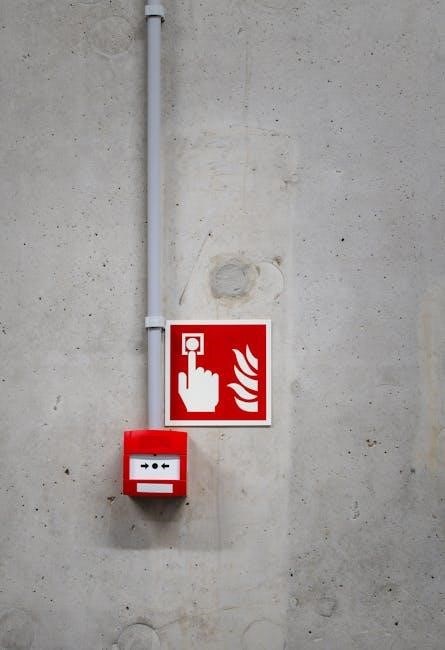
fire alarm manual call point
Discover everything about fire alarm manual call points in the UK. Learn installation, testing, and maintenance tips. Stay compliant with UK fire safety standards.
Manual call points are essential components of fire alarm systems, enabling individuals to trigger alarms in emergencies. These devices are typically wall-mounted red boxes.
Definition and Purpose of Manual Call Points
A manual call point (MCP) is a device that allows individuals to manually trigger a fire alarm system in emergency situations. Typically, these are wall-mounted red boxes with a glass panel or button that activates the alarm when broken or pressed. Their primary purpose is to provide a quick and accessible means for anyone to alert others of a potential fire hazard. MCPs are crucial in commercial, public, and residential spaces, ensuring rapid response to fire threats. They are designed to be simple to use, requiring minimal effort to activate, thus enhancing overall fire safety. By enabling immediate alarm activation, manual call points play a vital role in protecting lives and property, ensuring timely evacuation and firefighting responses.
Importance of Manual Call Points in Fire Safety
Manual call points are vital in fire safety systems as they provide a reliable means to quickly alert occupants and authorities of a fire. Their visibility and accessibility ensure that anyone can trigger the alarm, promoting swift evacuation and reducing potential damage. These devices complement automated fire detection systems by addressing situations where smoke or heat may not activate sensors promptly. By enabling early warning, manual call points help minimize risks to people and property, making them indispensable in both public and private settings. Their presence ensures compliance with fire safety regulations, enhancing overall safety protocols and providing peace of mind to building occupants. Regular testing and maintenance are essential to guarantee their effectiveness during emergencies.

Types of Manual Call Points
Manual call points include break-glass, push-button, and wireless models, each designed for quick activation in emergencies, ensuring reliable fire alarm triggering and enhanced safety responses.
Break-Glass Call Points
Break-glass call points are traditional fire alarm activation devices requiring a pane of glass to be broken to trigger the alarm. Universally recognized by their red color and distinctive design, these units are highly visible and intuitive to use. The glass pane serves as a barrier to prevent accidental activation, ensuring alarms are only triggered in genuine emergencies. Once broken, the mechanism activates the fire alarm system, alerting occupants and emergency services. Their simplicity and reliability make break-glass call points a common choice in commercial and public spaces. Regular testing and maintenance are essential to ensure functionality, adhering to safety standards like British Standard BS 5839-6:2019.
Push-Button Call Points
Push-button call points are a modern alternative to traditional break-glass units, offering a safer and more convenient method of manual fire alarm activation. Designed with a tamper-evident or tamper-proof mechanism, these devices prevent unauthorized use while ensuring easy operation in emergencies. They are particularly suitable for environments where breakable glass poses a hazard, such as food preparation areas or clean rooms. The push-button design allows for quick activation, and many models include visual indicators to confirm the alarm has been triggered. Regular testing and maintenance are straightforward, ensuring reliability and compliance with fire safety standards. Their ease of use and durability make push-button call points a popular choice in various commercial and public settings, enhancing overall fire safety and system responsiveness.
Wireless Manual Call Points
Wireless manual call points offer a flexible and innovative solution for fire alarm activation, eliminating the need for complex wiring. These devices utilize radio frequency or wireless mesh networks to communicate with the fire alarm system, ensuring reliable activation in emergencies. Their wireless nature simplifies installation, particularly in historic buildings or areas where wiring is impractical. Enhanced security features, such as encryption, prevent unauthorized activation, while long battery life reduces maintenance needs. Some models integrate with smart systems, providing real-time status updates and fault detection. Wireless call points are ideal for temporary structures or expanding existing systems, offering a modern, efficient alternative to traditional wired solutions without compromising safety or performance.

Installation Requirements
Manual call points must be installed near exits, at visible heights, and spaced to ensure full coverage. Compliance with local codes and standards is essential for effectiveness.
Placement and Visibility Guidelines
Manual call points must be installed in visible and accessible locations, typically near exits or escape routes, to ensure quick activation during emergencies. They should be positioned at a standard height, usually between 0.8 to 1.2 meters from the floor, to accommodate all individuals, including those with disabilities. The devices should be clearly visible and free from obstructions, such as curtains or signage, to avoid hindering access. Proper signage, including arrows or labels, can enhance visibility and guide users to the call points. Additionally, call points should be evenly distributed throughout the building to provide comprehensive coverage. Adherence to local fire safety codes and standards, such as British Standard BS 5839-6:2019, is crucial for effective placement and visibility. Proper installation ensures rapid response in emergency situations, saving valuable time and lives.
Height and Accessibility Standards
Manual call points must be installed at a uniform height to ensure accessibility for all individuals, including those with disabilities. The recommended height is typically between 0.8 and 1.2 meters from the floor, as specified by standards like British Standard BS 5839-6:2019. This range ensures that the device is easily reachable while standing or in a wheelchair. Additionally, call points should be positioned in areas with unobstructed access, avoiding placement behind furniture or curtains. Clear visibility and ergonomic placement are critical to allow quick activation during emergencies. Compliance with these standards ensures that manual call points are both accessible and effective in providing a reliable means of triggering fire alarms when needed.
Zoning and Mapping for Effective Coverage
Effective coverage of manual call points requires careful zoning and mapping within a building. This ensures that every area is adequately protected, with no blind spots. Zoning involves dividing the premises into distinct areas, each monitored by specific call points. Mapping ensures that call points are strategically placed to cover all escape routes, stairwells, and high-risk areas. Proper zoning and mapping enable rapid identification of an alarm’s origin, streamlining emergency response. British Standards recommend that each zone corresponds to a specific function or location, with call points clearly labeled for easy identification. This systematic approach enhances safety by ensuring comprehensive coverage and quick activation during emergencies, thereby safeguarding occupants effectively.

Testing and Maintenance
Regular testing and maintenance ensure manual call points function reliably. Weekly inspections, simulations, and annual checks by professionals maintain compliance and readiness.
Weekly Testing Procedures
Weekly testing of manual call points ensures reliability and compliance with fire safety standards. Begin by identifying all call points requiring inspection. Use a test key to activate each device, observing the fire alarm panel for proper activation. Verify that alarms sound and signals are received by monitoring systems. After testing, reset the system and document the process. Ensure no damage or tampering is present. british standards, such as BS 5839-6:2019, recommend these procedures to maintain system effectiveness. Regular testing helps prevent false alarms and ensures prompt emergency responses. Always follow manufacturer guidelines and local fire safety regulations during testing. Keep records of all tests for compliance audits and system maintenance tracking.
Monthly Inspection Checklist
A monthly inspection of manual call points involves a detailed examination to ensure functionality and compliance. Start by verifying the visibility and accessibility of all call points, ensuring they are unobstructed. Check for physical damage, tampering, or wear and tear. Test a sample of devices to confirm proper activation of the fire alarm system. Inspect the wiring and connections for any signs of deterioration. Review the test and maintenance history to identify recurring issues. Clean the call points to prevent dust buildup. Ensure all components, such as glass or buttons, are intact and functional. Check the alarm panel for any fault indicators related to manual call points. Complete the checklist and update records, addressing any identified issues promptly to maintain system reliability and safety standards.
Annual Maintenance Requirements
Annual maintenance for manual call points is crucial to ensure long-term reliability and compliance with safety standards. Begin with a comprehensive inspection of all devices, checking for wear, damage, or tampering. Clean the call points thoroughly to remove dirt or debris that could hinder functionality. Replace batteries in wireless models and test all units to ensure proper activation of the fire alarm system. Inspect wiring and connections for degradation or damage, addressing any issues promptly. Perform a full system test, including activation and reset procedures. Review and update maintenance records to track compliance with standards like BS 5839-6:2019. Finally, certify the system’s readiness and address any identified faults to maintain optimal performance and safety throughout the year;
Troubleshooting Common Issues
- Identify faults during regular testing to ensure reliability.
- Resolve false alarms by investigating triggers like dust or accidental activation.
- Repair damaged call points promptly to maintain system integrity.
Identifying Faults in Manual Call Points
Identifying faults in manual call points is crucial for maintaining reliable fire safety systems. Common issues include wear and tear, tampering, or environmental factors like dust or moisture. Fault detection involves testing the device’s functionality, such as activating the call point with a test key or checking LED indicators for error signals. Regular inspections should focus on wiring integrity, battery health, and proper installation. Faulty call points may fail to trigger alarms or cause false activations, posing significant risks. Advanced systems often provide diagnostic data through control panels, highlighting specific errors. Early identification ensures timely repairs, preventing system failures during emergencies. Always follow manufacturer guidelines for troubleshooting to maintain compliance with safety standards.
Resolving False Alarms
False alarms from manual call points can disrupt operations and reduce trust in fire safety systems. Common causes include accidental activation, environmental factors, or device malfunctions. To resolve false alarms, inspect the call point for damage or tampering. Ensure proper installation and alignment with British Standards like BS 5839-6:2019. Regular testing and maintenance, such as weekly inspections and annual servicing, help identify and address issues early. Environmental assessments can reveal factors like dust or humidity affecting the device. Advanced systems with anti-tamper features or addressable technology reduce false triggers. Training staff on proper use and conducting frequent drills can minimize accidental activations. Addressing these issues ensures reliable performance and compliance with fire safety regulations.
Repairing Damaged Call Points
Repairing damaged manual call points is crucial to ensure the reliability of fire alarm systems. Start by assessing the extent of damage, such as broken glass or faulty buttons. Replace any damaged components using compatible parts. After repairs, test the call point to confirm proper activation of the fire alarm system. Regular maintenance and inspections can prevent future issues. Ensure compliance with British Standards like BS 5839-6:2019 during repairs. Addressing repairs promptly maintains safety and prevents false alarms. Always consult professionals for complex fixes to guarantee system integrity and functionality. Proper repair ensures call points remain effective in emergencies, safeguarding people and property.

Regulatory Compliance
Regulatory compliance ensures fire alarm systems meet legal and safety standards. Adherence to British Standards like BS 5839-6:2019 and regular testing are crucial for reliability and accountability.
British Standards (BS 5839-6:2019)
British Standards BS 5839-6:2019 outline the requirements for fire alarm system planning, installation, and maintenance. This standard emphasizes weekly testing, monthly inspections, and annual maintenance to ensure reliability. It provides guidelines for the placement and visibility of manual call points, ensuring they are accessible and visible near exits. Compliance with BS 5839-6:2019 ensures fire safety systems meet legal and safety standards, reducing risks and ensuring timely emergency responses. Adherence to these standards is crucial for businesses and public premises to maintain fire safety regulations effectively.
Local Fire Safety Codes
Local fire safety codes provide region-specific requirements for manual call points, ensuring compliance with area regulations. These codes often mandate proper installation, placement, and testing of call points. They may specify height standards, visibility, and accessibility, aligning with international standards like BS 5839-6:2019. Regular inspections and maintenance are typically required to ensure functionality. Local codes may also address unique regional risks, such as seismic activity or extreme weather, influencing installation practices. Compliance with these codes is essential for legal adherence and fire safety preparedness, ensuring call points function effectively in emergencies. By following local codes, businesses and premises maintain safety standards tailored to their specific environment.
International Standards and Variations
International standards for fire alarm systems, including manual call points, vary by country but share common goals of ensuring safety and reliability. In the UK, BS 5839-6:2019 outlines specific requirements for installation, testing, and maintenance. Similarly, the U.S. NFPA 72 standard provides detailed guidelines for fire alarm systems, including manual pull stations. Europe adheres to EN 54, which specifies performance requirements for fire alarm components. Australia and New Zealand follow AS 1670.1, emphasizing proper placement and functionality. While variations exist, such as different installation heights or activation mechanisms, all standards prioritize rapid alarm activation and clear visibility. Compliance with these standards ensures that manual call points function effectively, regardless of regional differences, providing a consistent level of fire safety worldwide.

Advantages and Limitations
Manual call points offer rapid alarm activation, simplicity, and reliability, but may be prone to false alarms and require regular maintenance to ensure functionality and accuracy.
Benefits of Manual Call Points
Manual call points provide immediate and reliable fire alarm activation, ensuring prompt emergency responses. Their simplicity and accessibility make them indispensable in public spaces, offices, and residential areas. They are highly visible, reducing response delays, and their use is intuitive, requiring no special training. These devices enhance overall fire safety by allowing anyone to trigger an alarm, thereby protecting lives and property. Their presence also serves as a deterrent and a psychological reassurance, fostering a safer environment. Additionally, they are cost-effective and require minimal maintenance compared to advanced systems, making them a practical choice for fire safety compliance and emergency preparedness.
Limitations and Potential Drawbacks
Manual call points have several limitations, including susceptibility to false alarms, which can lead to disruptions and complacency. Their reliance on human intervention may result in delayed activation during emergencies. Additionally, they require regular testing and maintenance to ensure functionality, which can be time-consuming and costly. Physical damage to the units can render them inoperable, and their effectiveness depends on proper installation and placement. Furthermore, they may not integrate seamlessly with advanced fire alarm systems, limiting their utility in modern, high-tech environments. These drawbacks highlight the need for careful management and supplementary safety measures to ensure reliable fire protection.

Case Studies and Real-World Applications
Manual call points are widely used in commercial buildings, public spaces, and residential areas, proving effective in fire safety through real-world applications and practical implementations daily.
Manual Call Points in Commercial Buildings
Manual call points are crucial in commercial buildings for ensuring quick fire alarm activation. Strategically placed at exits and key locations, they enable rapid response during emergencies. Visibility and accessibility are prioritized, with bright red coloring and standardized installation heights. Regular testing, as per British Standards, ensures functionality. These devices complement automated systems, providing a reliable fallback option. Their presence in offices, malls, and factories underscores their importance in safeguarding occupants and assets, ensuring compliance with fire safety regulations and promoting a secure environment.
Use in Public Spaces and Stadiums
Manual call points are vital in public spaces and stadiums, where large crowds gather, ensuring swift fire alarm activation. Their bright red color and strategic placement at exits and key locations enhance visibility. Regular testing, as per British Standards, ensures reliability. These devices complement automated systems, providing a failsafe option during emergencies. Their presence in areas like stadiums and malls underscores their role in protecting large populations, ensuring compliance with fire safety regulations and fostering a secure environment for everyone.
Implementation in Residential Areas
Manual call points are increasingly being integrated into residential areas to enhance fire safety. In multi-story homes and apartment complexes, these devices are installed at strategic locations, such as near exits and on each floor. Their bright red color ensures visibility, making them easily accessible during emergencies. Residents can quickly trigger the alarm, ensuring timely evacuation and response from fire services. This implementation not only meets local fire safety codes but also provides peace of mind for homeowners. Regular testing, as outlined in standards like BS 5839-6:2019, ensures reliability. By installing manual call points, residential areas can significantly improve fire response times, protecting lives and property effectively.

Future Trends and Innovations
Future trends include smart technology integration, wireless systems, and enhanced security features for manual call points, improving reliability and ease of use in fire safety systems.
Smart Technology Integration
Smart technology is transforming manual call points by integrating them with IoT and wireless systems. Modern devices now offer real-time monitoring, remote diagnostics, and instant alerts via mobile apps. This connectivity enables faster response times and improved system reliability. Advanced data analytics can predict potential issues, reducing false alarms and downtime. Wireless call points eliminate the need for extensive wiring, simplifying installation and maintenance. Additionally, smart systems can integrate with building management software, providing a centralized control platform. These innovations enhance safety, efficiency, and compliance with evolving fire safety standards. The future of manual call points lies in seamless connectivity and intelligent automation, ensuring safer environments for all.
Wireless and Addressable Systems
Wireless and addressable systems are revolutionizing fire safety by enhancing the functionality of manual call points. Addressable systems allow each device to communicate directly with the control panel, providing precise location information during an alarm. This feature reduces response times and streamlines evacuation processes. Wireless systems eliminate the need for complex wiring, offering flexibility in installation and reducing maintenance costs. These systems are particularly beneficial in large or historic buildings where wiring is challenging. Advanced addressable systems also support two-way communication, enabling real-time status updates and diagnostics. The integration of wireless technology ensures reliability and scalability, making modern fire alarm systems more efficient and user-friendly. This combination of addressable and wireless capabilities sets a new standard for fire safety systems.
Enhanced Security Features
Modern manual call points now incorporate enhanced security features to prevent unauthorized activation and ensure system integrity. Anti-tamper mechanisms and encryption technologies safeguard against false alarms and malicious interference. Some systems utilize secure communication protocols to protect data transmission between devices and the control panel. Additionally, access-controlled call points require authorized personnel to activate the alarm, reducing accidental triggers. Real-time monitoring and event logging further enhance security by tracking system activity. These advancements ensure that manual call points remain reliable and secure, maintaining their critical role in fire safety while addressing potential vulnerabilities. Enhanced security features are essential for maintaining trust and effectiveness in fire alarm systems.
Manual call points are vital for fire safety, ensuring quick alarm activation in emergencies. Their reliability and compliance with standards make them indispensable in protecting lives and property effectively.
- Manual call points are critical components of fire safety systems, enabling quick activation of alarms in emergencies.
- They are typically wall-mounted red boxes, easily recognizable and accessible to everyone.
- These devices are linked to the fire alarm system, ensuring immediate notification of potential threats.
- Regular testing and maintenance, such as weekly checks, are essential for reliability and compliance with standards like BS 5839-6:2019.
- Proper installation, including visibility, height, and strategic placement, ensures effectiveness in emergency situations.
- Addressing false alarms and repairing damaged units promptly maintains system integrity and public trust.
- Manual call points are indispensable in commercial, public, and residential settings for safeguarding lives and property.
Final Thoughts on Manual Call Points
Manual call points are indispensable in fire safety, providing a reliable means to trigger alarms in emergencies. Their simplicity and accessibility make them crucial for prompt action, potentially saving lives and property. Regular maintenance and adherence to standards like BS 5839-6:2019 ensure their effectiveness. As technology advances, integrating smart features and wireless systems will enhance their functionality. Despite limitations, manual call points remain a cornerstone of fire safety systems, offering a fail-safe mechanism for emergency situations.
- Essential for rapid alarm activation in emergencies.
- Require regular testing and maintenance for reliability.
- Future innovations will improve functionality and integration.
- Remain a vital component of fire safety systems worldwide.